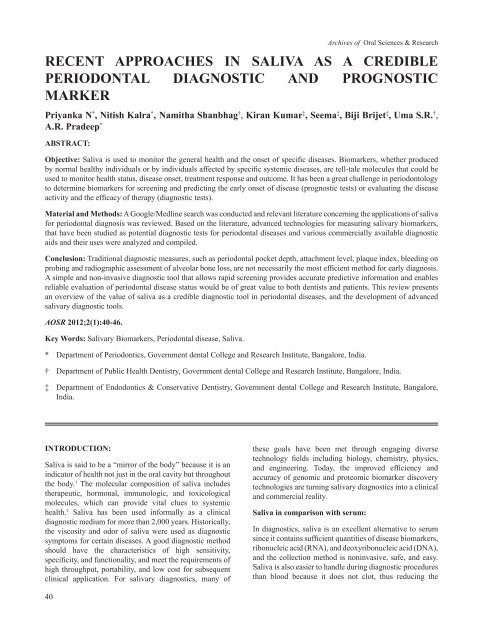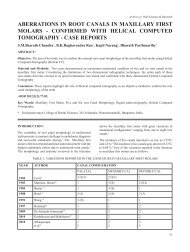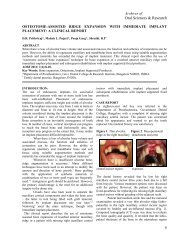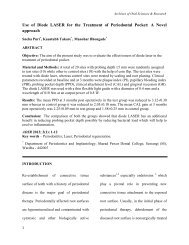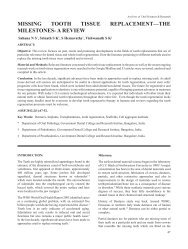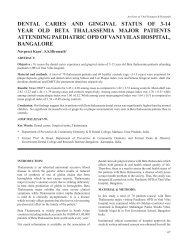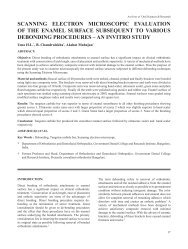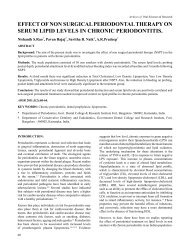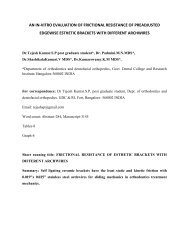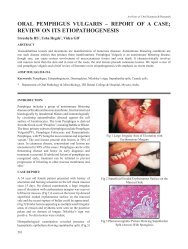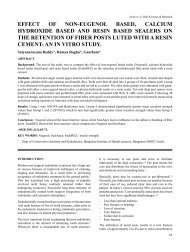recent approaches in saliva as a credible periodontal ... - Aosr.co.in
recent approaches in saliva as a credible periodontal ... - Aosr.co.in
recent approaches in saliva as a credible periodontal ... - Aosr.co.in
- No tags were found...
Create successful ePaper yourself
Turn your PDF publications into a flip-book with our unique Google optimized e-Paper software.
RECENT APPROACHES IN SALIVA AS A CREDIBLEPERIODONTAL DIAGNOSTIC AND PROGNOSTICMARKERPriyanka N * , Nitish Kalra * , Namitha Shanbhag † , Kiran Kumar ‡ , Seema ‡ , Biji Brijet ‡ , Uma S.R. † ,A.R. Pradeep *ABSTRACT:Objective: Saliva is used to monitor the general health and the onset of specific dise<strong>as</strong>es. Biomarkers, whether producedby normal healthy <strong>in</strong>dividuals or by <strong>in</strong>dividuals affected by specific systemic dise<strong>as</strong>es, are tell-tale molecules that <strong>co</strong>uld beused to monitor health status, dise<strong>as</strong>e onset, treatment response and out<strong>co</strong>me. It h<strong>as</strong> been a great challenge <strong>in</strong> periodontologyto determ<strong>in</strong>e biomarkers for screen<strong>in</strong>g and predict<strong>in</strong>g the early onset of dise<strong>as</strong>e (prognostic tests) or evaluat<strong>in</strong>g the dise<strong>as</strong>eactivity and the efficacy of therapy (diagnostic tests).Material and Methods: A Google/Medl<strong>in</strong>e search w<strong>as</strong> <strong>co</strong>nducted and relevant literature <strong>co</strong>ncern<strong>in</strong>g the applications of <strong>saliva</strong>for <strong>periodontal</strong> diagnosis w<strong>as</strong> reviewed. B<strong>as</strong>ed on the literature, advanced technologies for me<strong>as</strong>ur<strong>in</strong>g <strong>saliva</strong>ry biomarkers,that have been studied <strong>as</strong> potential diagnostic tests for <strong>periodontal</strong> dise<strong>as</strong>es and various <strong>co</strong>mmercially available diagnosticaids and their uses were analyzed and <strong>co</strong>mpiled.Conclusion: Traditional diagnostic me<strong>as</strong>ures, such <strong>as</strong> <strong>periodontal</strong> pocket depth, attachment level, plaque <strong>in</strong>dex, bleed<strong>in</strong>g onprob<strong>in</strong>g and radiographic <strong>as</strong>sessment of alveolar bone loss, are not necessarily the most efficient method for early diagnosis.A simple and non-<strong>in</strong>v<strong>as</strong>ive diagnostic tool that allows rapid screen<strong>in</strong>g provides accurate predictive <strong>in</strong>formation and enablesreliable evaluation of <strong>periodontal</strong> dise<strong>as</strong>e status would be of great value to both dentists and patients. This review presentsan overview of the value of <strong>saliva</strong> <strong>as</strong> a <strong>credible</strong> diagnostic tool <strong>in</strong> <strong>periodontal</strong> dise<strong>as</strong>es, and the development of advanced<strong>saliva</strong>ry diagnostic tools.AOSR 2012;2(1):40-46.Key Words: Salivary Biomarkers, Periodontal dise<strong>as</strong>e, Saliva.* Department of Periodontics, Government dental College and Research Institute, Bangalore, India.Archives of Oral Sciences & Research† Department of Public Health Dentistry, Government dental College and Research Institute, Bangalore, India.‡ Department of Endodontics & Conservative Dentistry, Government dental College and Research Institute, Bangalore,India.INTRODUCTION:Saliva is said to be a “mirror of the body” because it is an<strong>in</strong>dicator of health not just <strong>in</strong> the oral cavity but throughoutthe body. 1 The molecular <strong>co</strong>mposition of <strong>saliva</strong> <strong>in</strong>cludestherapeutic, hormonal, immunologic, and toxi<strong>co</strong>logicalmolecules, which can provide vital clues to systemichealth. 2 Saliva h<strong>as</strong> been used <strong>in</strong>formally <strong>as</strong> a cl<strong>in</strong>icaldiagnostic medium for more than 2,000 years. Historically,the vis<strong>co</strong>sity and odor of <strong>saliva</strong> were used <strong>as</strong> diagnosticsymptoms for certa<strong>in</strong> dise<strong>as</strong>es. A good diagnostic methodshould have the characteristics of high sensitivity,specificity, and functionality, and meet the requirements ofhigh throughput, portability, and low <strong>co</strong>st for subsequentcl<strong>in</strong>ical application. For <strong>saliva</strong>ry diagnostics, many ofthese goals have been met through engag<strong>in</strong>g diversetechnology fields <strong>in</strong>clud<strong>in</strong>g biology, chemistry, physics,and eng<strong>in</strong>eer<strong>in</strong>g. Today, the improved efficiency andaccuracy of genomic and proteomic biomarker dis<strong>co</strong>verytechnologies are turn<strong>in</strong>g <strong>saliva</strong>ry diagnostics <strong>in</strong>to a cl<strong>in</strong>icaland <strong>co</strong>mmercial reality.Saliva <strong>in</strong> <strong>co</strong>mparison with serum:In diagnostics, <strong>saliva</strong> is an excellent alternative to serums<strong>in</strong>ce it <strong>co</strong>nta<strong>in</strong>s sufficient quantities of dise<strong>as</strong>e biomarkers,ribonucleic acid (RNA), and deoxyribonucleic acid (DNA),and the <strong>co</strong>llection method is non<strong>in</strong>v<strong>as</strong>ive, safe, and e<strong>as</strong>y.Saliva is also e<strong>as</strong>ier to handle dur<strong>in</strong>g diagnostic proceduresthan blood because it does not clot, thus reduc<strong>in</strong>g the40
Diagnostic and Prognostic Markers <strong>in</strong> Saliva-Recent Approachessugars, tox<strong>in</strong>s, prote<strong>in</strong>s and antibodies. 7,11-15 Build<strong>in</strong>g onthis technology, a se<strong>co</strong>nd cl<strong>as</strong>s of m<strong>in</strong>iaturized sensorsystem h<strong>as</strong> been pioneered that <strong>co</strong>nta<strong>in</strong>s beads with<strong>in</strong>etch<strong>in</strong>gs of sta<strong>in</strong>less steel plates and utilizes a membranecapture element <strong>in</strong>tegrated <strong>in</strong>to a fluidics structure. 16,17These membrane microchip ensembles have been adaptedto service cell, spore, and bacteria separation and biomarkeridentification applications. 18 Importantly, the performancemetrics of these m<strong>in</strong>iaturized sensor systems have beenshown to closely <strong>co</strong>rrelate with established macros<strong>co</strong>picgold-standard methods, mak<strong>in</strong>g them suitable for use <strong>as</strong>sub<strong>co</strong>mponents of highly functional detection systems forthe analysis of <strong>co</strong>mplex fluid samples, such <strong>as</strong> <strong>saliva</strong>, fora variety of analyte systems. 9,11-17,19-23 The developmentof a po<strong>in</strong>t of care (POC) device that <strong>co</strong>nta<strong>in</strong>s a modularand m<strong>in</strong>iaturized sensor system, universal analyzer withfunctional <strong>in</strong>tegrated mechanical/optical <strong>in</strong>terfaces, andflexible microchip architecture can service the future needsof cl<strong>in</strong>icians and the research <strong>co</strong>mmunities.In this POC device, <strong>saliva</strong> (100–300 μl) is placed <strong>in</strong>to the<strong>saliva</strong>ry <strong>co</strong>llection/delivery module, and then delivered<strong>in</strong>to the Nano-Biochip. The <strong>in</strong>jection-molded cartridge is`creditcard'size and encloses the array Nano-Biochip where <strong>co</strong>mplexfluorescent immuno<strong>as</strong>says are performed. Here, a networkof fluidic <strong>co</strong>mponents ensures the <strong>co</strong>mplete transfer andprocess of <strong>saliva</strong> samples to the multiplex bead array toprovide quantitative <strong>in</strong>formation of target biomarkers ofdise<strong>as</strong>e. The sample <strong>in</strong>troduction requirements are <strong>co</strong>nsistentwith the use of <strong>saliva</strong> or f<strong>in</strong>ger-prick quantities of bloodthat can be directly <strong>in</strong>troduced <strong>in</strong>to the sample <strong>in</strong>troductionport. Detection reagents are stored dry on a <strong>co</strong>njugatepad embedded with<strong>in</strong> the biochip, and are re<strong>co</strong>nstituted<strong>as</strong> needed, through the rele<strong>as</strong>e of a prepacked buffer<strong>co</strong>nta<strong>in</strong>ed <strong>in</strong> biochip-<strong>in</strong>tegrated pouches. All process<strong>in</strong>gsteps are <strong>co</strong>nducted with<strong>in</strong> the microfluidic network of thebiochip via actuation <strong>in</strong>side the analyzer without human<strong>in</strong>tervention. These features elim<strong>in</strong>ate the need for externalfluidics, such <strong>as</strong> pumps, tub<strong>in</strong>g and <strong>co</strong>nnectors. Therefore,the <strong>in</strong>tegrated system h<strong>as</strong> the potential to reduce <strong>co</strong>st andreduce the risk for leaks and <strong>co</strong>ntam<strong>in</strong>ation. The <strong>as</strong>say isprocessed entirely through a 5–15 m<strong>in</strong> sequence that isprogrammed <strong>in</strong> the ma<strong>in</strong> <strong>co</strong>ntroller board. The flexibilityof the <strong>co</strong>ntrol software allows for modifications to be madethrough an <strong>as</strong>say builder <strong>in</strong>terface. Control over the flowrate, <strong>in</strong>cubation time and reagent w<strong>as</strong>h, is achieved bythe actuation of stepp<strong>in</strong>g motors that direct the fluid flowthrough the depression of the fluid pouches. The sample isdirected to an on-chip w<strong>as</strong>te reservoir, which provides <strong>as</strong>afe <strong>co</strong>nta<strong>in</strong>ment of biohazardous fluids. The entire biochipcan be discarded <strong>as</strong> solid w<strong>as</strong>te after the <strong>as</strong>say, facilitat<strong>in</strong>gbiohazard w<strong>as</strong>te management. Together, these essentialfeatures serve to facilitate the transition from chips-<strong>in</strong>a-laboratoryto a lab-on-a-chip, and offer significantopportunities for POC technology needs.Table 2: DEMONSTRATES VARIOUS PRODUCTS AND THEIR USES FOR MEASURING SALIVARY BIOMARKERSPRODUCT NAMEPURPOSEMyPerioIDidentifies the type and <strong>co</strong>ncentration of the specific bacteria that cause <strong>periodontal</strong>dise<strong>as</strong>es.My PerioPathdeterm<strong>in</strong>es the cause of <strong>periodontal</strong> <strong>in</strong>fections.Oral Fluid NanoSensor Testsimultaneous and precise detection of multiple <strong>saliva</strong>ry prote<strong>in</strong>s and nucleic acids.Electronic T<strong>as</strong>te Chipsdetects multiple biomarkers for early diagnosis of <strong>periodontal</strong> dise<strong>as</strong>eOraQuick an antibody test that provides results <strong>in</strong> 20 m<strong>in</strong>utes, usually detects HIV 1 and HIV 2Integrated MicrofluidicPlatform for Oral Diagnosticsrapidly (3–10 m<strong>in</strong>) me<strong>as</strong>ures the <strong>co</strong>ncentrations of MMP-8 and other biomarkers <strong>in</strong> smallamounts (10 ml) of <strong>saliva</strong>43
Priyanka N et al.Newer aids for me<strong>as</strong>ur<strong>in</strong>g <strong>saliva</strong>ry biomarkers:Significant advances are <strong>in</strong> development for the screen<strong>in</strong>gof <strong>periodontal</strong> dise<strong>as</strong>es. 24 The current method of diagnos<strong>in</strong>gperiodontitis is through <strong>as</strong>sessment of cl<strong>in</strong>ical parametersand radiographs, however, this is not necessarily the mostefficient method for early diagnosis. If <strong>periodontal</strong> dise<strong>as</strong>esare detected early, treatment can be e<strong>as</strong>ier and less pa<strong>in</strong>fulfor the patient. Left untreated, <strong>periodontal</strong> dise<strong>as</strong>es maylead to systemic problems such <strong>as</strong> cardiov<strong>as</strong>cular dise<strong>as</strong>eand diabetes. Therefore, early screen<strong>in</strong>g for <strong>periodontal</strong>dise<strong>as</strong>es is essential dur<strong>in</strong>g dental exam<strong>in</strong>ations.MyPerioID and My PerioPath § :Two DNA-b<strong>as</strong>ed <strong>saliva</strong> tests are available. MyPerioPathand MyPerioID. My PerioPath uses a <strong>saliva</strong> sample toidentify the type and <strong>co</strong>ncentration of the specific bacteriathat cause <strong>periodontal</strong> dise<strong>as</strong>es. MyPerioID test also uses<strong>saliva</strong> to determ<strong>in</strong>e a patient’s genetic susceptibility to<strong>periodontal</strong> dise<strong>as</strong>es and which patients are at higher riskof more serious <strong>periodontal</strong> <strong>in</strong>fections. Both tests requirethe shipp<strong>in</strong>g of <strong>saliva</strong> samples to a laboratory for results.Oral Fluid Nano Sensor Test:The University of California, Los Angeles (UCLA)Collaborative Oral Fluid Diagnostic Research Center,partnered with eng<strong>in</strong>eers at the UCLA School ofEng<strong>in</strong>eer<strong>in</strong>g, developed a micro electromechanical systemb<strong>as</strong>ed electrochemical detection platform that is capable ofreal-time, ultr<strong>as</strong>ensitive, ultr<strong>as</strong>pecific multiplex detectionof <strong>saliva</strong>ry prote<strong>in</strong> and RNA biomarkers. 25 This envisionedproduct h<strong>as</strong> been labeled the Oral Fluid Nano Sensor Test(OFNASET). It is a po<strong>in</strong>t-of-care, automated, and e<strong>as</strong>y-touse<strong>in</strong>tegrated system that will enable simultaneous andprecise detection of multiple <strong>saliva</strong>ry prote<strong>in</strong>s and nucleicacids. In addition, this system is portable and <strong>co</strong>uld be usednot only <strong>in</strong> the doctor’s office, but also <strong>in</strong> any other healthcarestation to perform an <strong>in</strong>stant po<strong>in</strong>t-of-care diagnosis.The OFNASET technology platform <strong>co</strong>mb<strong>in</strong>es cutt<strong>in</strong>gedgetechnologies, such <strong>as</strong> self-<strong>as</strong>sembled monolayersbionanotechnology, cyclic enzymatic amplification, andmicrofluidics, with several well-established techniques<strong>in</strong>clud<strong>in</strong>g micro<strong>in</strong>jection mold<strong>in</strong>g, hybridization-b<strong>as</strong>eddetection, and molecular purification. The <strong>in</strong>tended use ofthe OFNASET is for the po<strong>in</strong>t of care multiplex detectionof <strong>saliva</strong>ry biomarkers for oral cancer. It analyzes <strong>saliva</strong>for the presence of four <strong>saliva</strong>ry mRNA biomarkers(SAT, ODZ, IL-8, and IL-1b) and two <strong>saliva</strong>ry proteomicbiomarkers (thioredox<strong>in</strong> and IL-8).§ Oral DNA ® Labs Inc, Brentwood, Tennessee, USAǁ Ora Sure Technologies, Inc, Bethelem, USAElectronic T<strong>as</strong>te Chips:Several study groups have reported elevated serum CRPlevels <strong>in</strong> periodontitis patients. The higher the levels of CRP<strong>in</strong> periodontitis patients, the more severe the dise<strong>as</strong>e, evenwith adjustments for external factors. 7 The biomarker CRPis an acute ph<strong>as</strong>e reactant and a well-accepted <strong>in</strong>dicator of<strong>in</strong>flammation. Numerous cl<strong>in</strong>ical studies have establishedelevated serum CRP <strong>as</strong> a strong, <strong>in</strong>dependent risk factor forthe development of cardiov<strong>as</strong>cular dise<strong>as</strong>e (CVD). CVD h<strong>as</strong>also been <strong>as</strong>sociated with oral <strong>in</strong>fections (i.e. <strong>periodontal</strong>dise<strong>as</strong>es) and there is evidence that systemic CRP may bea l<strong>in</strong>k between the two. Cl<strong>in</strong>ical me<strong>as</strong>urements of CRP <strong>in</strong>serum are currently performed with "high sensitivity'' CRP(hsCRP) enzyme-l<strong>in</strong>ked immunosorbent <strong>as</strong>say (ELISA)tests that lack the sensitivity for the detection of thisimportant biomarker <strong>in</strong> <strong>saliva</strong>. Salivary CRP may representa novel approach for diagnos<strong>in</strong>g and monitor<strong>in</strong>g chronic<strong>in</strong>flammatory dise<strong>as</strong>e, <strong>in</strong>clud<strong>in</strong>g CVD and <strong>periodontal</strong>dise<strong>as</strong>es.Chemically sensitized bead microreactors with<strong>in</strong> the labon-a-chipsystem were <strong>recent</strong>ly applied for me<strong>as</strong>urementof CRP and other biomarkers of <strong>in</strong>flammation <strong>in</strong> <strong>saliva</strong>,demonstrat<strong>in</strong>g significantly lower detection level (by > 3decade orders of magnitude) for CRP than high-sensitivityCRP ELISA methods, allow<strong>in</strong>g for me<strong>as</strong>urement of<strong>in</strong>flammatory biomarkers related to select dise<strong>as</strong>e states. 7Currently, researchers at Rice University <strong>in</strong> Houston,Tex, are develop<strong>in</strong>g a lab-on-a-chip system us<strong>in</strong>g a newdetection system for me<strong>as</strong>ur<strong>in</strong>g analytes <strong>in</strong> <strong>saliva</strong> b<strong>as</strong>ed onan electronic t<strong>as</strong>te chip (ETC). The ETC methodology w<strong>as</strong><strong>co</strong>mpared with the standard laboratory technology (ELISA)for me<strong>as</strong>ur<strong>in</strong>g CRP <strong>in</strong> <strong>saliva</strong>, and displayed a 20-fold lowerlimit of detection than the ELISA. With this technique itw<strong>as</strong> possible to quantitate the difference <strong>in</strong> CRP levelsbetween healthy <strong>in</strong>dividuals and patients with <strong>periodontal</strong>dise<strong>as</strong>es. 7 Additional studies <strong>co</strong>nfirmed the ability of theETC platform to simultaneously monitor several additionalbiomarkers. 7 The prospect of a <strong>co</strong>mmercially available ETClab-on-a-chip platform that can detect multiple biomarkersfor early diagnosis of <strong>periodontal</strong> dise<strong>as</strong>e is promis<strong>in</strong>g.Oraquick ǁ :It is an antibody test that provides results <strong>in</strong> 20 m<strong>in</strong>utes.The blood, pl<strong>as</strong>ma or oral fluid is mixed <strong>in</strong> a vial withdevelop<strong>in</strong>g solution, and the results are read from <strong>as</strong>ticklike test<strong>in</strong>g device. Usually detects HIV 1 and HIV 2.The Oraquick rapid <strong>saliva</strong> HIV test is def<strong>in</strong>itely the way togo. It is a toothbrush-like device with a fabric swab on thehead and a small pl<strong>as</strong>tic stem. The stem naps off to avoid<strong>co</strong>ntam<strong>in</strong>ation, while the swab is <strong>in</strong>serted <strong>in</strong>to a tube oftest<strong>in</strong>g fluid. The test<strong>in</strong>g tube is e<strong>as</strong>ily sealed and ready fortransport to a test<strong>in</strong>g laboratory. By us<strong>in</strong>g a toothbrush-likedevice that is <strong>in</strong>serted <strong>in</strong>to the mouth <strong>in</strong>stead of draw<strong>in</strong>gblood, this test<strong>in</strong>g method makes an already high-anxiety44
Diagnostic and Prognostic Markers <strong>in</strong> Saliva-Recent Approachesscreen<strong>in</strong>g a little more <strong>co</strong>mfortable.Integrated Microfluidic Platform for Oral Diagnostics(IMPOD):A cl<strong>in</strong>ical po<strong>in</strong>t-of care diagnostic test that enables rapidquantification of an oral dise<strong>as</strong>e biomarker <strong>in</strong> human <strong>saliva</strong>by us<strong>in</strong>g a monolithic disposable cartridge designed tooperate <strong>in</strong> a <strong>co</strong>mpact analytical <strong>in</strong>strument w<strong>as</strong> reported. 26,27This microfluidic method facilitates hands-free <strong>saliva</strong>analysis by <strong>in</strong>tegrat<strong>in</strong>g sample pretreatment (filter<strong>in</strong>g,enrichment, mix<strong>in</strong>g) with electrophoretic immuno<strong>as</strong>saysto quickly me<strong>as</strong>ure analyte <strong>co</strong>ncentrations <strong>in</strong> m<strong>in</strong>imallypretreated <strong>saliva</strong> samples. Rapid (< 10 m<strong>in</strong>) me<strong>as</strong>urementof levels of the <strong>co</strong>llagen cleav<strong>in</strong>g enzyme MMP-8 <strong>in</strong> <strong>saliva</strong>from healthy and <strong>periodontal</strong>ly dise<strong>as</strong>ed subjects can beachieved us<strong>in</strong>g 20 µl of <strong>saliva</strong>. 26 B<strong>as</strong>ed on this, a portablediagnostic device called the IMPOD w<strong>as</strong> developed. Anearly cl<strong>in</strong>ical study <strong>in</strong> which the hand-held IMPOD w<strong>as</strong>used to rapidly (3–10 m<strong>in</strong>) me<strong>as</strong>ure the <strong>co</strong>ncentrations ofMMP-8 and other biomarkers <strong>in</strong> small amounts (10 ml) of<strong>saliva</strong> h<strong>as</strong> been reported. 27CONCLUSION:Saliva is be<strong>in</strong>g accepted <strong>as</strong> an excellent diagnostic mediumand an <strong>in</strong>dispensable tool <strong>in</strong> the field of diagnostics. It islikely that the development of <strong>saliva</strong> b<strong>as</strong>ed methods willimpact and expand the role of dentists. Integrat<strong>in</strong>g thesenew <strong>saliva</strong>ry diagnostics methods <strong>in</strong>to cl<strong>in</strong>ical practice isimportant to aid dental professionals <strong>in</strong> mak<strong>in</strong>g essentialhealth-related decisions for patients. In the near future,tak<strong>in</strong>g a <strong>saliva</strong> sampl<strong>in</strong>g <strong>in</strong> a dental cl<strong>in</strong>ic will be<strong>co</strong>me <strong>as</strong>rout<strong>in</strong>e <strong>as</strong> obta<strong>in</strong><strong>in</strong>g a ur<strong>in</strong>e or serum sample at a physician’soffice.REFERENCES:1. Mandel ID. Salivary diagnosis: promises, promises.Ann N Y Acad Sci 1993;694:1-10.2. Zhang L, Xiao H, Wong DT. Salivary biomarkers forcl<strong>in</strong>ical applications. Mol Diagn Ther 2009;13:245-259.3. Johnson LR. Salivary Secretion. G<strong>as</strong>tro<strong>in</strong>test<strong>in</strong>alPhysiology. 6th Edition. Mosby; St. Louis, MO, USA:2001; 65-74.4. Oberg SG, Izutsu KT, Truelove EL. Human parotid<strong>saliva</strong> prote<strong>in</strong> <strong>co</strong>mposition: dependence on physiologicalfactors. Am J Physiol 1982;242:231–236.5. Rudney JD, Kajander KC, Smith QT. Correlationsbetween human <strong>saliva</strong>ry levels of lysozyme, lactoferr<strong>in</strong>,<strong>saliva</strong>ry peroxid<strong>as</strong>e and secretory immunoglobul<strong>in</strong> Awith different stimulatory states and over time. ArchOral Biol 1985;30:765–771.6. Tabak LA. Po<strong>in</strong>t-of-care diagnostics enter the mouth.Ann NY Aad Sci 2007;1098:7-14.7. Christodoulides N, Mohanty S, Miller CS etal. Application of microchip <strong>as</strong>say system for theme<strong>as</strong>urement of C-reactive prote<strong>in</strong> <strong>in</strong> human <strong>saliva</strong>.Lab Chip 2005;5:261–269.8. Floriano PN, Christodoulides N, Romanovicz D et al.Membrane-b<strong>as</strong>ed on-l<strong>in</strong>e optical ana lysis system forrapid detection of bacteria and spores. BiosensBioelectron 2005; 20:2079–2088.9. Floriano PN, Christodoulides N, Miller CS et al. Useof <strong>saliva</strong>-b<strong>as</strong>ed nano-biochip tests for acute myocardial<strong>in</strong>farction at the po<strong>in</strong>t of care: a fe<strong>as</strong>ibility study. Cl<strong>in</strong>Chem 2009; 55:1530–1538.10. Wong DT. Salivary diagnostics for oral cancer. J CalifDent Assoc 2006;34;303-308.11. Christodoulides N, Tran M, Floriano PN et al. Amicrochip-b<strong>as</strong>ed multianalyte <strong>as</strong>say system for the<strong>as</strong>sessment of cardiac risk. Anal Chem2002;74:3030–3036.12. Curey TE, Goodey A, Tsao A et al. Characterization ofmulti<strong>co</strong>mponent monosaccharide solutionsus<strong>in</strong>g an enzyme-b<strong>as</strong>ed sensor array. Anal Biochem2001;293:178–184.13. Goodey A, Lavigne JJ, Savoy SM et al.Development of multianalyte sensor arrays <strong>co</strong>mposedof chemically derivatized polymeric microsphereslocalized <strong>in</strong> micromach<strong>in</strong>ed cavities. J Am Chem Soc2001;123:2559–2570.14. McCleskey SC, Griff<strong>in</strong> MJ, Schneider SE, McDevitt JT,Anslyn EV. Differential receptors create patternsdiagnostic for ATP and GTP. J Am Chem Soc2003;125: 1114–1115.15. Ali MF, Kirby R, Goodey AP et al. DNA hybridizationand discrim<strong>in</strong>ation of s<strong>in</strong>gle-nucleotide mismatchesus<strong>in</strong>g chip-b<strong>as</strong>ed microbead arrays. Anal Chem 2003;75:4732–4739.16. Rodriguez WR, Christodoulides N, Floriano PN et al.A microchip CD4 <strong>co</strong>unt<strong>in</strong>g method for HIV monitor<strong>in</strong>g<strong>in</strong> resource-poor sett<strong>in</strong>gs. PLoS Med 2005;2:e182.17. Christodoulides N, Floriano PN, A<strong>co</strong>sta SA et al.Toward the development of a lab-on-a-chip dualfunctionleukocyte and C-reactive prote<strong>in</strong> analysismethod for the <strong>as</strong>sessment of <strong>in</strong>flammation and cardiacrisk. Cl<strong>in</strong> Chem 2005;51:2391–2395.18. Cohen J. Monitor<strong>in</strong>g treatment: at what <strong>co</strong>st? Science2004;304(5679):1936.45


